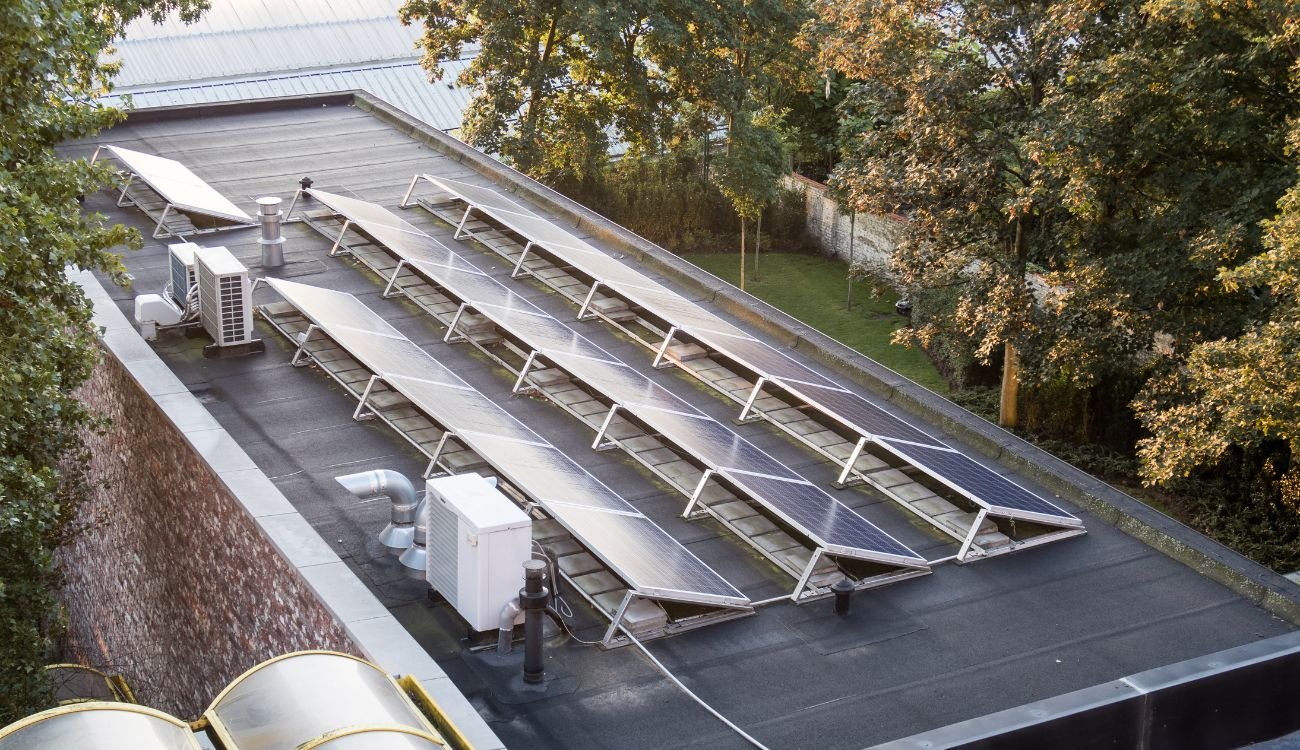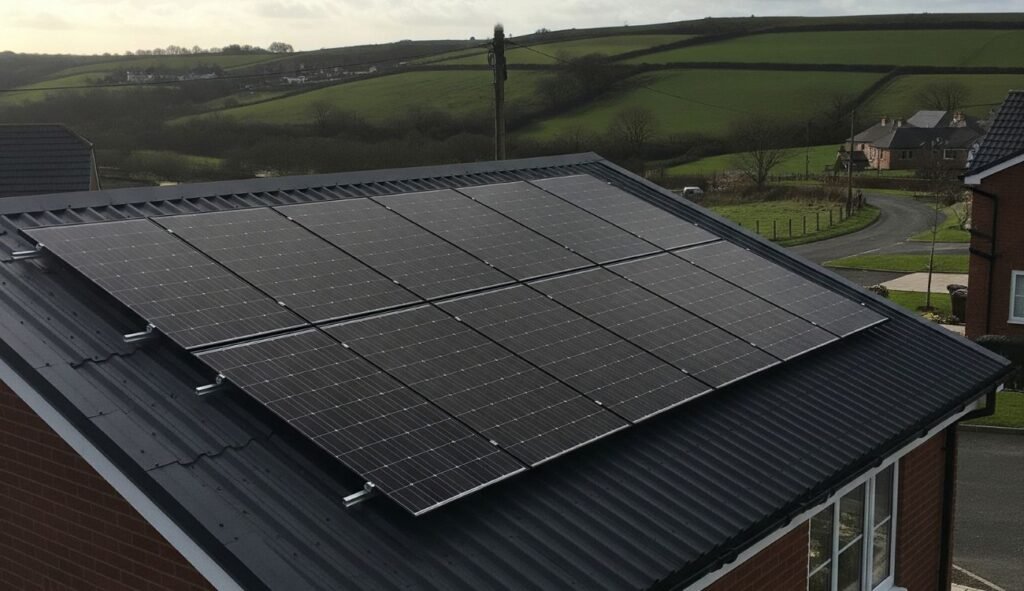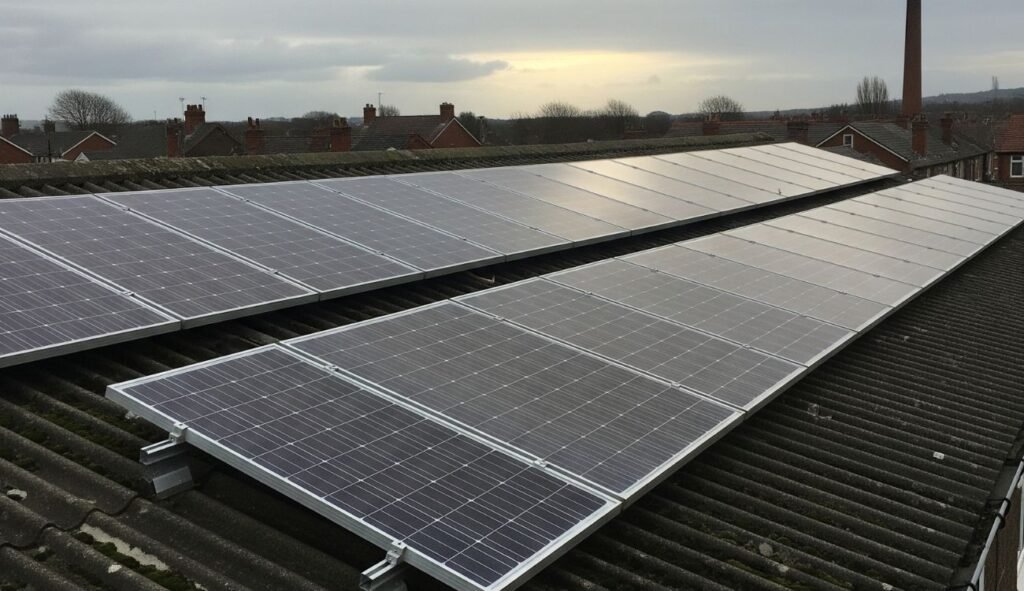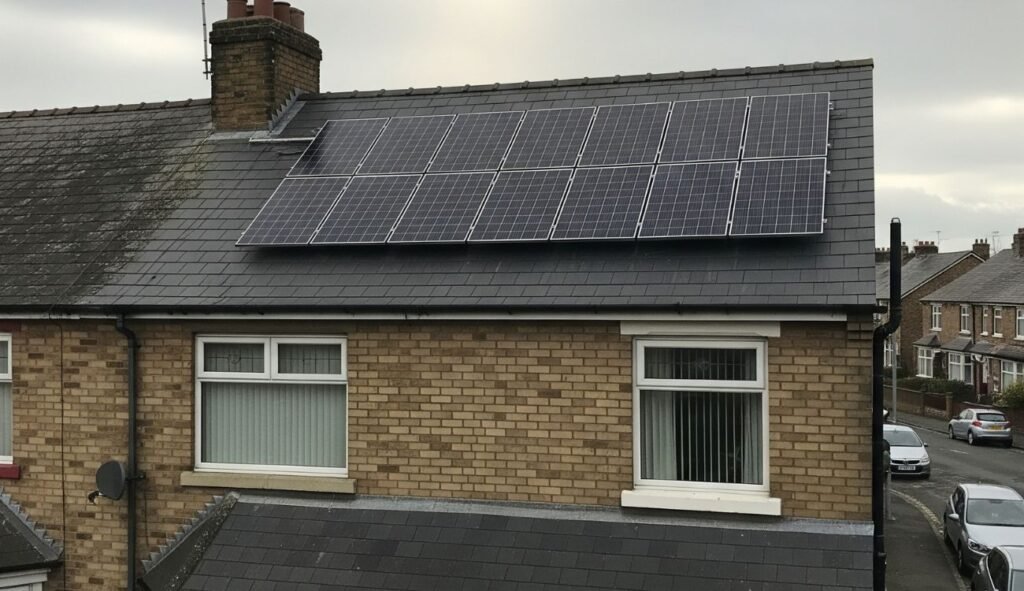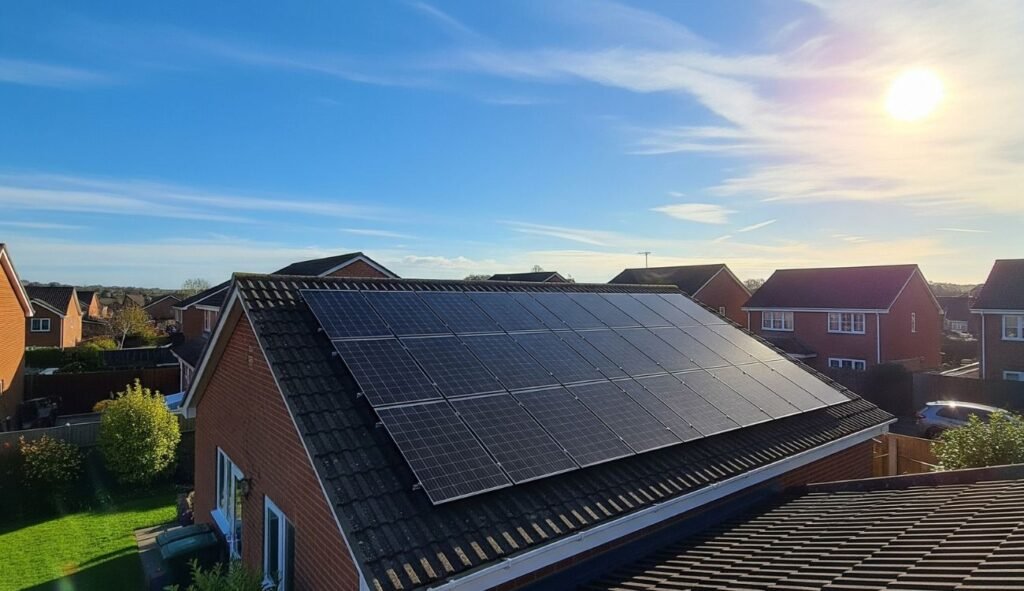Flat roof solar panels are transforming underutilised roof space into powerful energy-generating assets.
Whether you’re a UK homeowner aiming to reduce energy bills, a landlord improving EPC ratings, or a business seeking sustainability, installing solar panels on a flat roof offers a high-ROI solution without compromising aesthetics or structure.
In this post, we’ll discuss the feasibility, benefits, installation methods, and key considerations for installing solar panels on a flat roof in the UK.
From government incentives like the Smart Export Guarantee to technical specs and installer tips, this guide is your all-in-one resource.
Can Solar Panels Be Installed onto a Flat Roof?
Yes, solar panels can absolutely be installed on a flat roof and in many cases, they offer more flexibility than pitched roofs.
In fact, flat roof solar panel systems are increasingly popular for UK homeowners, landlords, and commercial property owners looking to harness renewable energy without compromising on roof integrity or aesthetics.
If you are wondering how many solar panels you can actually fit on your roof, flat roofs usually give you a lot more usable space than pitched ones, so you’ve got way more flexibility when it comes to how many panels you can install.
How Do Solar Panels Work on a Flat Roof?
Solar panels on a flat roof operate the same way as on pitched roofs—they convert sunlight into electricity using photovoltaic (PV) cells.
However, the installation process differs slightly due to the need for mounting systems that angle the panels for optimal sun exposure.
Flat roof solar systems are typically mounted using a specialised frame or ballast system that tilts the panels at an optimal angle (usually between 10° and 30°) to maximise energy generation.
These systems are often non-penetrative, meaning they don’t require drilling into the roof structure. This provides an ideal solution for properties where maintaining waterproofing is essential.
Installers strategically position the panels to avoid shading, ensure adequate ventilation, and prevent wind uplift, all of which contribute to long-term performance and system efficiency.
Two common systems are:
| Ballasted Mounting Systems | Fixed-Rack Mounting Systems |
|---|---|
| Use weights (e.g., concrete blocks) to secure panels. | Mechanically anchored into the roof structure. |
| Non-penetrative, ideal for membrane or felt roofs. | Used where wind load or structural design requires extra security. |
| Minimal impact on waterproofing. |
Are there limitations?
- Roof Load-Bearing Capacity: Always check if your roof can support the weight.
- Shading: Ensure minimal obstruction from nearby structures or vents.
- Wind Load: Especially critical in exposed coastal or high-rise areas.
Tip: Always request a structural survey and wind-load analysis before installation.
Considering solar panels for a flat roof? Future Heat is MCS certified and proudly serves Tyne and Wear, Newcastle, and the North East with tailored flat roof solutions that maximise efficiency without compromising your roof’s integrity. Get your free solar panel quote today.
What are the benefits of installing solar panels on a flat roof?
Flat roofs provide design flexibility and unobstructed space, ideal for optimising solar panel placement.
Unlike pitched roofs, you can adjust the panel angle precisely to capture maximum sunlight year-round.
| Optimised Orientation | Panels can be tilted southward at the ideal angle (30–40°) regardless of roof direction. |
| Aesthetic Integration | Panels are less visible from street level, maintaining curb appeal, ideal for landlords and homeowners. |
| Easier Maintenance | Accessibility for cleaning and inspections is simpler and safer on flat roofs. |
| Greater Space Utilisation | Flat roofs typically offer large, unobstructed areas, allowing for bigger solar arrays and higher energy output. This becomes especially useful when trying to determine how many solar panels you would need to meet your household or commercial energy needs. |
| Improved Panel Cooling | Better airflow under tilted panels on flat roofs helps maintain lower temperatures, boosting solar efficiency. |
| Future Expansion Friendly | Additional panels can be easily added later to meet growing energy demands. |
| Reduced Shading | Fewer roof obstructions mean less shading, maximising sunlight exposure throughout the day. |
| Multi-functional Roof Use | Solar panels can be integrated with green roofs or other rooftop equipment, making the most of available space. |
What are disadvantages of flat roof solar panels?
| Potential Water Pooling | Flat roofs may have drainage issues, causing water to pool around panels and risk leaks if not properly managed. |
| Increased Installation Costs | Additional mounting structures are needed to tilt panels, which can raise the overall installation price. |
| Wind Exposure Risks | Panels tilted on flat roofs may be more exposed to strong winds, requiring more robust mounting to prevent damage. |
| Space Constraints | Limited usable area if roof space is cluttered with HVAC units, vents, or other equipment common on flat roofs. |
| Reduced Efficiency in Winter | Panels tilted less steeply may collect more snow, reducing solar exposure and energy generation during colder months. |
| Structural Load Concerns | Flat roofs need to be assessed for weight capacity since added mounting systems and panels increase load. |
Why Flat Roof Solar Panels Are a Great Option for Homes, Landlords, and Businesses
Homeowners benefit from reduced energy bills, landlords can improve EPC ratings and attract tenants, and commercial buildings can significantly cut operational costs while improving sustainability credentials.
Homeowners: Maximise space, cut bills
If your home has a flat roof extension, garage, or outbuilding, you can use that space for solar without affecting the main roof.
This is perfect for homeowners wanting to preserve the character of their property.
Example: A bungalow in Surrey added a 4kW system on a flat-roof garage, saving around £550 annually.
Landlords: Improve EPC ratings and property value
Solar PV can significantly increase a rental property’s EPC rating. This is vital, as UK regulations (MEES) require a minimum EPC rating of E to legally let a property.
- Tenant Benefits: Lower electricity bills = higher satisfaction and retention.
- Landlord Benefits: Compliance with MEES, enhanced rental appeal.
Businesses: Reduce overheads and improve ESG scores
Commercial flat roofs offer large surface areas ideal for solar, which makes many businesses suitable for solar panels. The result?
- Lower energy costs.
- Eligibility for Enhanced Capital Allowances (ECAs).
- Boosted Environmental, Social & Governance (ESG) performance.
What Are the Costs and ROI for Flat Roof Solar Panels?
When considering flat roof solar panels, it’s important to weigh both the upfront investment and the potential return in energy savings.
The cost and return on investment (ROI) can vary significantly depending on the size of the system and the type of property it’s installed on.
Below is a breakdown of typical costs and estimated annual savings for residential, small business, and commercial solar panel systems to help you understand what to expect.
| Property Type | System Size | Approx. Cost (Before VAT) | Est. Annual Savings |
|---|---|---|---|
| Residential | 4kW | £5,000–£6,500 | £500–£650 |
| Small Business | 10kW | £9,000–£12,000 | £1,100–£1,400 |
| Commercial | 50kW+ | £35,000+ | £5,000+ |
Note: Prices vary based on location, mounting system, and installer. Additionally, knowing the best time to install solar panels is crucial for maximising your savings and efficiency.
Timing can make a significant difference, especially when considering seasonal sunlight variations and local incentives.
What’s the ROI?
- Typical payback period: 6–9 years (quicker for commercial).
- Return on Investment (ROI): 8–12% annually.
- Panel lifespan: 25+ years with minimal degradation (~0.5% per year).
You can improve your return even further by incorporating battery storage. Read our guide on what size solar battery you need to make an informed decision.
And if you’re wondering when is the best time to install solar panels to maximise your savings and efficiency, timing can definitely make a difference, especially considering seasonal sunlight variations and local incentives.
What Incentives Are Available for Flat Roof Solar Panels in the UK?
The UK government and energy suppliers offer various financial incentives to encourage solar adoption.
From export tariffs to VAT relief and business tax allowances, these schemes improve the affordability and return on investment for solar panels installed on flat roofs.
Smart Export Guarantee (SEG)
Under SEG, you’re paid for surplus energy you export to the grid.
- Administered by: Ofgem.
- Eligibility: Must be installed by an MCS-certified installer and use an MCS-certified product.
VAT Relief
- 0% VAT for residential installations until 2027 (as part of the UK Net Zero plan).
Commercial Grants and Tax Relief
- Some local authorities offer grants or green loans.
- ECAs allow businesses to deduct the full cost of solar from taxable profits.
Do You Need Planning Permission to Install Solar Panels on a Flat Roof?
Most flat roof solar panel installations are covered under permitted development rights, so in many cases, you won’t need planning permission.
However, there are important conditions you must meet to stay within the rules:
- Panels must not project more than 200mm above the roof surface.
- They should be set back from the edges of the roof to reduce visual impact.
- The property must not be a listed building or located in a conservation area.
To avoid any issues, it’s always best to check with your local planning authority or speak to a qualified installer who understands the latest regulations.
It might be tempting to try installing solar panels yourself, but there’s a lot to think about before going down that route
Building regulations
- Electrical works must comply with Part P.
- Structural integrity must meet Part A.
- Fire safety considerations (especially for commercial installations) are addressed under Part B.
What to Consider When Choosing a Solar Installer for Flat Roofs?
Not all solar installers specialise in flat roof systems, so it’s crucial to choose a solar panel installer who is a qualified professional with relevant experience.
The right installer will help you navigate structural requirements, select appropriate mounting systems, and ensure eligibility for incentives like SEG.
What qualifications should installers have?
- MCS Certification: Required for SEG payments and government incentives.
- RECC Membership: Ensures consumer protection.
- Experience with flat roof systems: Ask for portfolio examples.
Questions to ask your installer
- Have you installed flat roof systems before?
- Will you conduct a structural survey?
- What mounting system will be used?
- How do you manage water drainage around panels?
Frequently Asked Questions (FAQs)
Yes, many flat roof systems use ballasted mounting, which relies on weights to hold the panels in place, no drilling required. This protects waterproof membranes and is ideal for buildings with sensitive roofing.
Most residential flat roof installations take 1–2 days, while larger commercial projects may take up to a week, depending on system size and roof access.
Yes, if your property is in a conservation area, planning permission is usually required. Check with your local planning authority for specific guidance.
Yes, like all solar systems, flat roof panels benefit from occasional cleaning and annual inspections to check for debris, water pooling, or mounting integrity.
Installing solar panels on a flat roof can affect your building’s insurance, but in most cases, it simply means you need to inform your insurance provider about the installation. Some insurers may adjust your premium slightly due to the added value or perceived risk, while others may require specific cover for the panels themselves.
It’s important to ensure that your policy includes protection against damage, theft, and liability related to the solar panels. Always check with your insurer before installation to avoid any coverage issues.
Our Verdict
Choosing to invest in solar energy is a smart step toward long-term savings, improved property value, and environmental responsibility. Whether you’re a UK homeowner looking to lower your electricity bills, a landlord aiming to boost EPC ratings and rental appeal, or a commercial property owner seeking energy independence, a flat roof offers untapped potential.
With flexible installation options, government-backed incentives like the Smart Export Guarantee, and strong returns on investment, now is an ideal time to explore solar solutions tailored to your roof type and usage needs.
Myles Robinson is a seasoned expert in the boiler and home improvement industry, with over a decade of experience. He is deeply committed to environmental sustainability, actively promoting energy-efficient heating solutions to help households reduce their carbon footprint. By combining industry expertise with a dedication to environmental responsibility, Myles continues to lead efforts in transforming home heating practices towards a more sustainable future.

